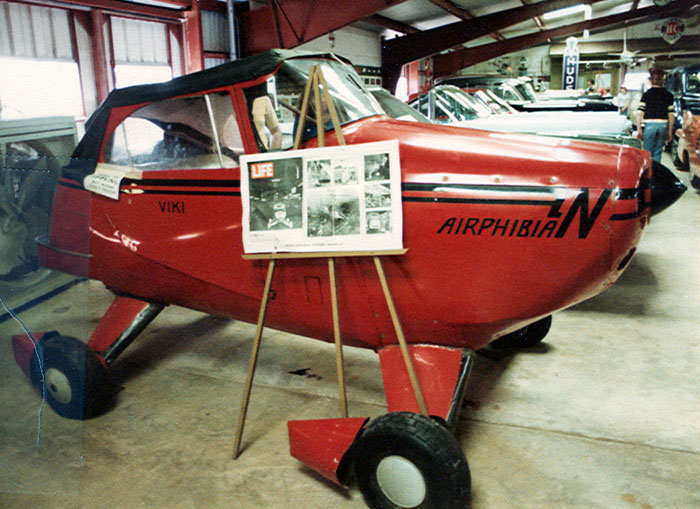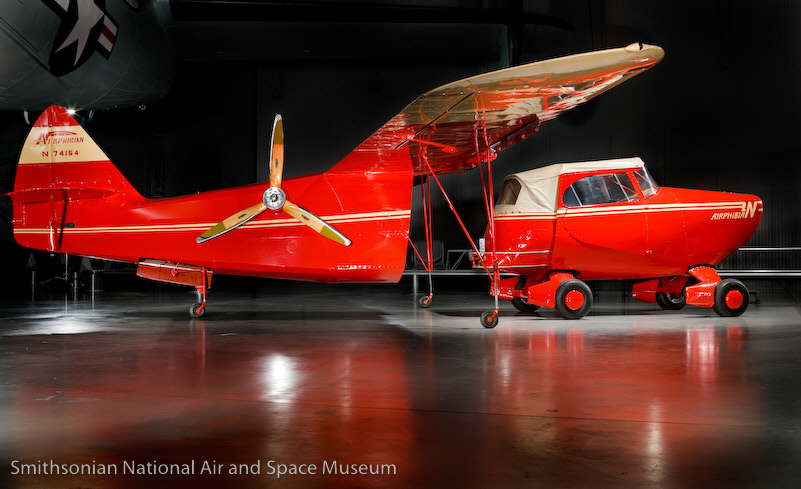| Fulton | |
 |
|
|
Airphibian Photo: Robert Deering Pate Museum of Transportation Cresson, Texas |
|
|
In 1950, the Fulton Airphibian became the first roadable aircraft, an aircraft designed to be used as a car or an airplane, to be certificated by the Civil Aviation Administration. Other roadable aircraft had already been built, for example Waldo Waterman's Arrow/Aerobile and William Stout's Skycar, both of which are in the NASM collection--as well as other designs, but none won certification. In 1945, Robert Fulton Jr., developed his Airphibian as a flexible means of business and personal transportation. He flew his own aircraft around the country for government contract work, and quite often he had been left at airports with unreliable or inadequate means of transportation into towns. The roadable aircraft would provide air travel to an airport and, with the disengagement of the wings and tail, it would become a car, capable of being driven to the final destination. To acquire the funding for design, certification, and production, Fulton formed Continental, Inc. at the Danbury Airport, Connecticut. Fulton designed the Airphibian as a high-wing monoplane, similar in appearance to a Stinson Voyager but with a distinctive four-wheel landing gear with fairings/fenders. It had a conventional fabric-covered steel-tube aft fuselage and empennage, straight tapered cantilever wings of metal rib and fabric construction, and a semi-monocoque forward fuselage that was detachable and roadable. The first prototype flew in 1945 and the first production prototype test flight was May 21, 1947. Ground handling was considered excellent in both the roadable and airplane configurations. Normal turning of the steering wheel provided steering on the road. The right rudder pedal provided normal brake operation, the left pedal operated the clutch, and an accelerator provided power. The engine drove the rear wheels through a torque converter, drive shaft, combined transmission and differential, and universal joints. All four wheels could be braked for ground operations; only the rear two wheels could be braked for taxiing. Normal speeds were 110 mph in the air and 55 mph on the ground. The propeller, rear fuselage, and wings were removed for road operations. Attachment to the aircraft was accomplished by backing the car to the fuselage, leveling the tail and wings, moving three locking levers that inserted and locked large pins into fittings. The spar and tail parts slid into horizontally-inclined U-fittings. After locking into place, the two outrigger wheels that support the wings and the retractable tail wheel were cranked up into storage position. The propeller was removed from its bracket on the side of the fuselage, the prop spinner was removed, the propeller screwed on with a built-in wrench, and the spinner replaced again. The engine would not start if everything was not properly connected. In December 1950 the CAA approved the FA-2 with a strut-braced wing and 150 hp electric drive engine. The first production model, FA-2-101, N74153, flew in 1950. It had an Aircooled Motors 6A4150-B-3 modified engine. A cantilever wing model, the FA-3 was certificated by the CAA in June 1952 and the production model, FA-3-101, was flown shortly thereafter. This aircraft, N74154, is NASM's aircraft. Robert Fulton received an order for eight production models, to be used by CAA inspectors themselves, and they were built but not delivered. Instead, several company officers felt that that they were not getting enough of a return on their investment in the certification process, so, in 1953, they pulled out of the deal, taking the financial backing and several Airphibians with them. The Airphibian represents a technical success as a flying car, but did not become a marketable design. The prototypes were driven over 200,000 miles and made more than 6,000 car/plane conversions. The conversion process, however, was judged to be too complicated and lengthy. Performance in the air was considered sluggish due to the weight penalty of automotive parts, a perennial problem in aerocars. Therefore, the search for a practical flying car continues today. Nonetheless, the Airphibian was the first aircar to receive CAA certification and only the Taylor Aerocar, which was inspired by the Airphibian, has received certification as well. SPECIFICATIONS: Source: Smithsonian National Air & Space Museum |
|
 Photo: Smithsonian National Air and Space Museum |
|
|
